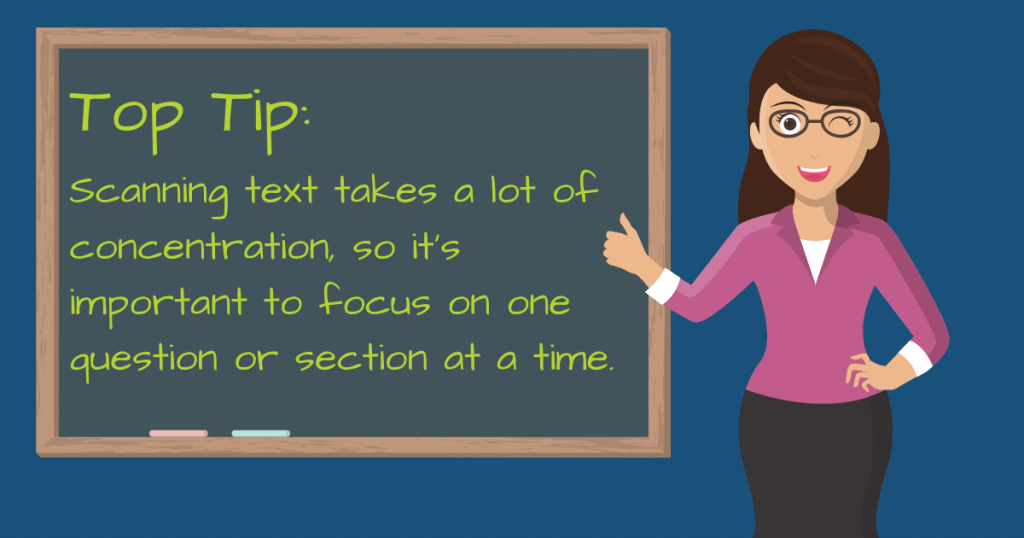
Healthcare professionals need to be able to read quickly to understand content while still retaining key information. Whether you're a doctor reading through a patient's medical records or a nurse trying to identify care instructions, being able to scan text is important.
To help you, we've put together an informative guide to scanning that you can use in Reading Part A. You will learn:
- What scanning is
- How it is different from skimming
- Why scanning is important
- How to scan.
What is scanning?
Scanning is looking through a text quickly to find specific information. It involves rapid eye movements and keywords to advance quickly through a text.
Depending on what you're reading, this can include details such as:
- Dates
- Names
- Care instructions
- Drug dosages
What's the difference between skimming and scanning?
Readers often confuse scanning with another reading skill: skimming. While they both involve reading through a text quickly, they involve searching for different kinds of information.
| Skimming: | Scanning: |
| Checking the text for relevance OR finding a relevant section of text to read in more detail | Looking for specific information |
Let's take a look at an example to help show the difference:
- 11/5: Mr Brown attended a consultation for a foot ulcer
- 13/5: Mr Brown was diagnosed with Type 2 Diabetes.
Skimming these two lines would lead to the conclusion that this is information about Mr Brown's medical history, which may be relevant if you are treating Mr Brown. If not, you would ignore it and continue skimming. Scanning, on the other hand, would lead you to a number of key details such as:
- Name: Mr Brown
- Dates: 11/5 and 13/5
- Symptom: Foot ulcer
- Diagnosis: Type 2 Diabetes
The information you scan will depend on the question or the type of information you are searching for. You need to know this before you start scanning to be most time-efficient.
Why is scanning important?
Scanning is not unique to healthcare, everyone uses it frequently in their everyday life. For doctors, nurses and other healthcare professionals who tend to be more time-poor, it is an essential skill to quickly find and action information.
Time spent reading through a document could be time spent helping a patient. Further, due to the information in these documents being highly important to diagnose and care, finding the information needed for this individual patient’s circumstances is critical.
How do I scan for information?
Scanning allows you to quickly move through large amounts of information to find specific information. To do this you will need to skip large chunks of information, focusing only on the correct information you're looking for. However, you also need to do this effectively or you risk missing key information.
Take a look at the steps below to help you scan effectively:
1. Know what you're looking for
Before you start scanning, you will already have a good idea of what detail it is you are looking for. This will help you move your eyes quickly over the page to find what you want to know. You can also start scanning anywhere in the text (top, bottom, middle, right, left) but use text features such as headings, sub-headings and bullet points to help you decide the most likely location for where you will find the information you are looking for.
2. Identify key terms and move quickly
Once you know what you're looking for, identify the key terms, phrases or names you need to look for. For example, it may be your task to check when the patient had their last dose of medication. Looking at their patient record, you will ignore all the information which is not about medication.
3. Read the rest of the text
When you find the key details, read the surrounding words (and sentences if necessary). For example, once you have found the section of the patient’s record which lists their medications, move your eyes quickly to check the last time recorded for when the medication was given.

Using Scanning in Reading Part A
In Reading Part A, the best way to answer the sentence completion and short answer questions will be to use scanning techniques.
In a sentence completion question, the words around the gap help you identify what type of word you are looking for. They also give you the keywords to scan for in the text to narrow down what you need to read to maybe one or two sentences.
Here’s an example:
Make sure the patient isn’t wearing any (17) _______________________ on the part of the body where the plaster backslab is going to be placed.
In this sentence, the words before the gap ‘wearing any’ and the words after the gap ‘on the part of the body’ tell us that the missing word is going to be a plural noun. It could be an adjective + a noun. The verb ‘wearing’ also helps to narrow the category of the noun to words for clothes or other items worn on the body.
The words ‘plaster backslab’ are keywords to scan the text for to help you find the exact noun (+ adjective) which will complete this gap. From already answering the matching questions you will have a good idea of which text you think is most likely to contain the keywords and you can go to this text and start scanning your eyes to find these words. The answer to complete the sentence will be close by.
For more information about OET Reading, make sure you check out the OET Blog. You will find the information tips, strategies and guides that can help you get the results you need.